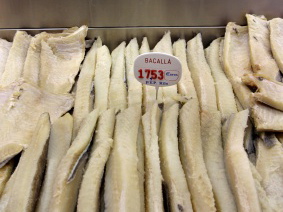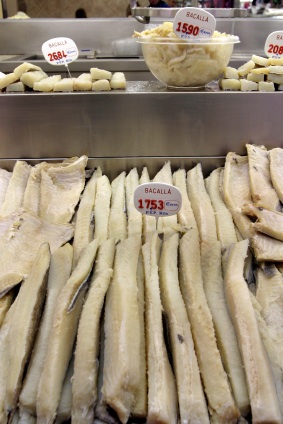
reference-image, l
(article, Lucy Burningham)
[%pageBreakSettings nobreak=true] In 1997, when journalist Mark Kurlansky published Cod: A Biography of the Fish That Changed the World, he stirred stagnant waters. John McPhee’s [%bookLink code=0374512973 Oranges], a journalistic look at how a familiar item could influence human behavior and shape history, had been sitting on the shelves for more than 30 years. Cod revived this microhistory genre by telling the combined tale of a slow-moving, cold-water fish and the humans who, for a thousand years, caught it, traded it, ate it, and built empires with it. The book was a bestseller and inspired a wave of similar books, including Kurlansky’s own Salt and [%bookLink code=0345476395 "The Big Oyster"] as well as [%bookLink code=0807050091 "The Secrets of Saffron"], [%bookLink code=0767906241 Caviar], [%bookLink code=0061147834 Spice], [%bookLink code=0865475784 "The Potato"], and [%bookLink code=0743250222 "Robbing the Bees"]. Driving Kurlansky’s fishy story is a modern conundrum we’ve come to know all too well: the causes and effects of environmental pillaging. The book begins with a salty smack in the face, following a group of modern Canadian fishermen struggling to sustain their livelihood on overfished seas. Just a few pages into the book, Kurlansky outlines the beginning of the end: these people are “at the wrong end of a 1,000-year fishing spree.” Propelled by this small morsel of demise, Kurlansky moves back in time and begins charting an expertly paced, chronological navigation through a fascinating history. He begins with the Basques, who had salt and boats and knew how to use both, as early as the year 1000. Fishing in a then-secret location (the shores of modern Canada) and salting the fish down as they caught it, the Basques transformed flaky cod fillets into nonperishable, protein-rich sustenance. Cod preserved en masse became food for the masses; the salty stuff sustained the Vikings and large populations throughout Europe during the Middle Ages. And when explorers began claiming territories in the New World, cod became the food that fed colonialism. [%image cod float=left width=250 credit="Photo: iStockphoto/lillisphotography" caption="Salted cod for sale in a Barcelona market."] Cod made colonials rich. The Pilgrims — who settled not far from a hook of land that later became known as Cape Cod — progressed from a struggling society of picky eaters to a well-fed, commercial power thanks to cod, selling the fish to Europe and the West Indies. Fishing techniques and boats, including the schooner (which became an important naval weapon during the American Revolution), evolved according to efficiency. Catches got bigger not because there were more fish, but because fishing became more effective. Fishing rights created rifts between Britain and New England, then between the northern and southern U.S. states. As a microhistory, Cod succeeds because Kurlansky stays on topic without overloading his narrative. Cod’s authoritative voice, its insistence on a cod-centric viewpoint, never feels didactic or desperate, only persuasive. In addition to the strong narrative, the book includes black-and-white illustrations, photos, and woodcuts. Even in paperback, the small images are a great help — demystifying, say, the laborious difficulty of correctly ripping, cutting, and splitting a whole cod. (In 1895, for example, a 211-pound, six-foot-long codfish was caught off the Massachusetts coast. That's no small fry.) Kurlansky relies on familiar figures and literary texts to help create context, most noticeably in the epigraphs. James Joyce depicts Leopold Bloom as a carnivorous gastronome who enjoys fried cod roe for breakfast. Thoreau describes a Provincetown fishery in 1851. William Carlos Williams writes the fewer-than-20-words poem “The Cod Head” in 1932. Cod tells a story of environmental ignorance and economic greed, but it’s also a history of appetites. Even today, many populations crave the firm-fleshed fish; think British fish and chips, the many Mediterranean versions of fish and potatoes, or American frozen fish sticks. At least one recipe punctuates the end of every chapter; from a Danish television editor’s 1990s recipe for fresh cod with mustard sauce (best eaten with potatoes, hardboiled eggs, beets, horseradish, and schnapps) to the 1682 recipe for “Stockfish” from London that begins, “Beat it soundly with a Mallet for half an hour or more,” the recipes are a reminder that, despite all the tariffs, treaties, and philosophizing, this is fundamentally a story about food. (A further sampling of six centuries’ worth of cod recipes appears at the end of the book, in an appendix called “A Cook’s Tale.”) [[block(sidebar). h1.Featured recipe]] But the recipes won’t satisfy the cooking purist, as most refer to the Atlantic cod. These days, only 10 percent of that fish population remains, although most American grocery stores do sell other kinds of cod. (The Monterey Bay Aquarium Seafood Watch program recommends buying Pacific cod, black rockfish, and black cod instead.) In the end, Kurlansky delivers what he promised in the prologue: an explanation of exactly why so few cod swim in the Atlantic today. And while there’s no doubt that Cod serves as a we-should-have-known-better book, Kurlansky’s use of well-researched facts creates a navigational chart to ecological crisis and therefore, a sliver of hope. Maybe we will know better next time. p(bio). Lucy Burningham is a freelance writer living in Portland, Oregon.

reference-image, l

feature-image, l

promo-image, l

cod, l

featurette-image, l